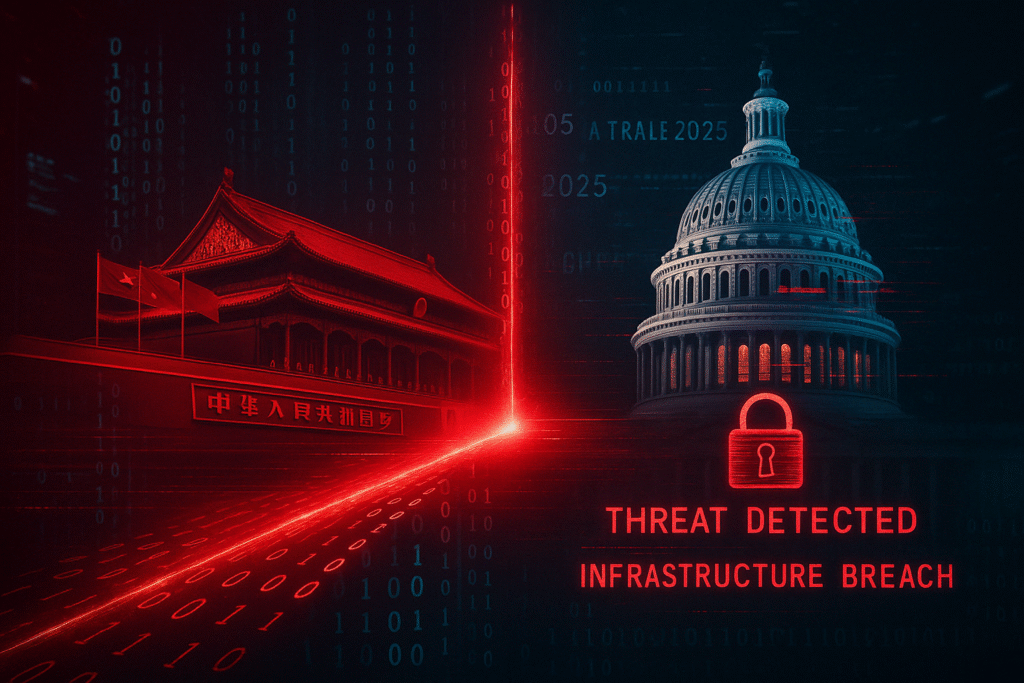
In the wake of the April 2025 U.S. tariff hike on Chinese imports, a new surge of cyberattacks swept across America’s digital infrastructure. Chinese state-sponsored hackers quickly infiltrated telecom networks, energy grids, and sensitive government systems. These weren’t isolated incidents—they were part of a broader campaign of China cyber espionage, timed to retaliate against economic sanctions and foreign policy moves.
As the U.S.–China trade conflict escalates, so does the risk of tariff-related cyberattacks. Beijing’s hackers are no longer just stealing data,they’re embedding in critical infrastructure, prepositioning for disruption, and turning cyber retaliation into a tool of economic warfare.
This blog unpacks how Chinese state-sponsored hacking is reshaping global cybersecurity. From advanced persistent threat groups like Volt Typhoon to strategic infrastructure breaches, we examine the tactics, motivations, and defense strategies essential for navigating the era of trade war cybersecurity.
We cover emerging threats like these every week. Subscribe to our newsletter for regular insights on AI-enabled attacks, Chinese state-sponsored hacking, and strategies for digital resilience.
What Is China Cyber Espionage?
Definition and Purpose
China cyber espionage refers to state-sponsored cyberattacks conducted by Chinese government-backed groups, aimed at extracting sensitive information from foreign governments, corporations, and infrastructure systems. These operations are not isolated incidents. They are part of a broader digital strategy that blends surveillance, economic coercion, and asymmetric power projection.
The primary objectives include:
- Strategic leverage, by gaining access to critical infrastructure and government systems targeted through China cyber espionage operations..
- Economic advantage, through the theft of intellectual property and trade secrets, often extracted during tariff-related cyberattacks on high-value sectors.
- Political intelligence, via the monitoring of officials, diplomats, and policy operations, a hallmark of Chinese state-sponsored hacking.
CISA estimates that Chinese actors steal between $400 and $600 billion in U.S. intellectual property each year. These campaigns typically intensify during moments of political or economic tension, particularly in response to sanctions or trade disputes. As trade war cybersecurity becomes more critical, China cyber espionage continues to escalate as a preferred method of retaliation.
Timeline of Escalation
Modern China cyber espionage began accelerating in 2015, when hackers stole the personal data of over 21 million federal employees during the OPM breach. Activity surged again in 2018 as the U.S.-China trade war began. Since then, cyber retaliation has been closely linked to economic confrontation and diplomatic escalation.
The emergence of Volt Typhoon and Salt Typhoon has marked a new phase of sustained infrastructure-focused operations. These incidents are examples of economic retaliation cyberwarfare, with long-term infiltration replacing traditional cybercrime tactics.
Known APT Groups
China’s cyber strategy is executed through well-documented advanced persistent threat (APT) groups, each playing a distinct role in the ecosystem of Chinese state-sponsored hacking:
- Volt Typhoon specializes in long-term infiltration of U.S. infrastructure and uses built-in system tools to avoid detection. Their campaigns align with major trade policy flashpoints, particularly tariff announcements and sanctions enforcement.
- Salt Typhoon focuses on telecom surveillance and gained access to nine U.S. firms in 2024, a direct example of China cyber espionage supporting political and economic intelligence collection.
- APT41 blends state-backed espionage with cybercrime and has targeted healthcare, gaming, and defense sectors, often during periods of diplomatic conflict or public disputes.
- Earth Alux deploys custom malware like MASQLOADER and VARGEIT to bypass traditional endpoint defenses. Their campaigns reflect the growing sophistication of trade war cybersecurity threats across both public and private networks.
Each of these groups operates as part of a broader strategy of economic retaliation cyberwarfare, leveraging technical stealth to achieve long-term advantage.
Volt Typhoon’s Infrastructure Breach
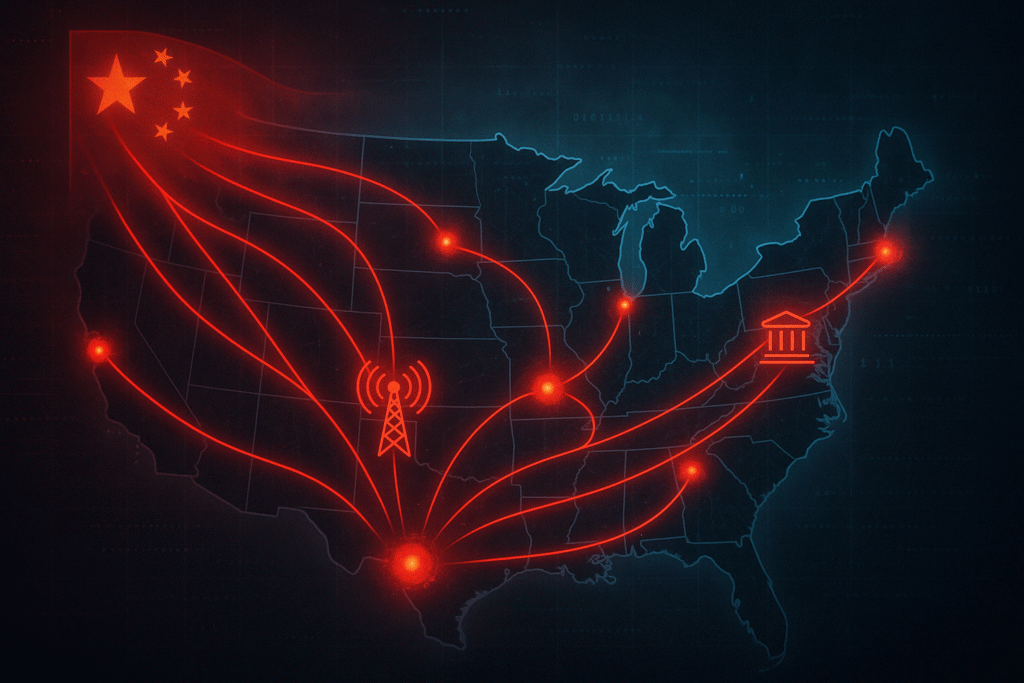
Between 2023 and 2025, Volt Typhoon executed a stealth campaign targeting ports, utilities, and transportation infrastructure across the United States. The group remained inside several systems for months, using native tools and avoiding detection by traditional malware scanners. In a secret diplomatic meeting in late 2024, Chinese officials admitted the operation was a warning linked to U.S. support for Taiwan and aggressive tariff enforcement.
This breach was one of the most overt examples of tariff-related cyberattacks used as retaliation for trade policy. It also demonstrated how China cyber espionage has evolved from passive surveillance to active threat staging, a pattern consistent with Chinese state-sponsored hacking doctrine.
The Volt Typhoon campaign exemplifies how economic retaliation cyberwarfare has become a calculated element of foreign policy. These campaigns are part of a larger system of trade war cybersecurity risks that extend far beyond the private sector.
How Tariff Policies Spark Cyber Retaliation
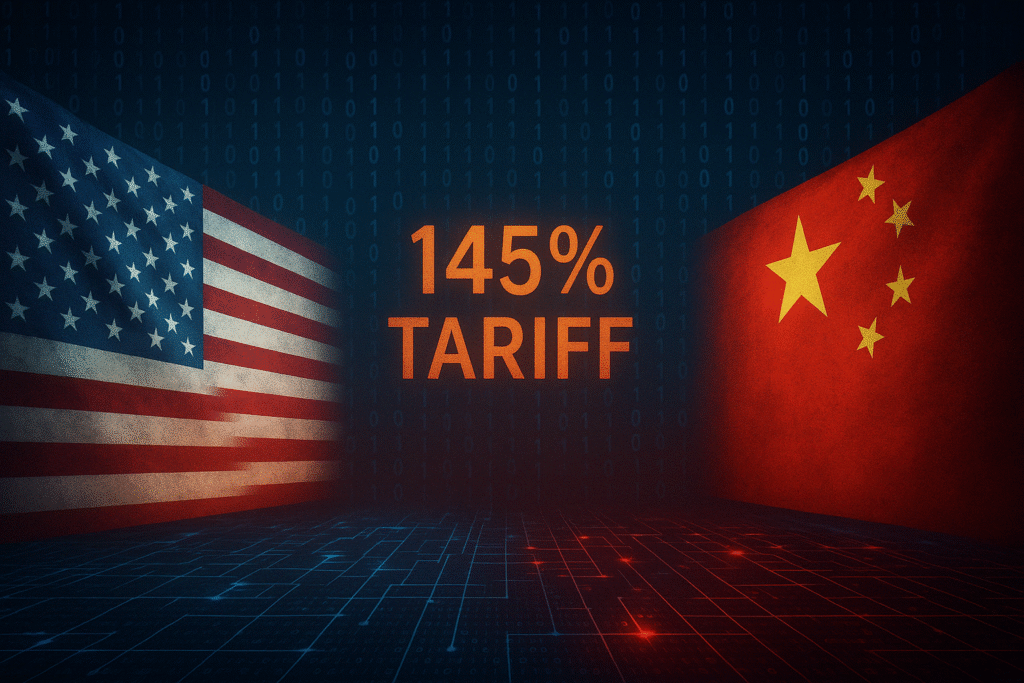
U.S. Tariff Escalations Since 2018
The U.S.–China trade war began in 2018 and intensified over the years, peaking in April 2025 with a 145 percent tariff on Chinese imports. The move triggered backlash in Beijing and a corresponding surge in cyber intrusions across U.S. sectors tied to trade, including telecommunications, logistics, and defense.
Trade policy is no longer separate from cybersecurity. Each new tariff package has been followed by targeted cyberattacks from Chinese actors. These are not coincidental. They are part of a deliberate digital strategy tied to China cyber espionage and economic retaliation cyberwarfare.
Cyber Retaliation as Economic Warfare
China views tariffs as economic aggression and responds with asymmetric tactics. Cyberattacks allow for immediate, scalable retaliation without formal escalation. These operations are aimed at creating disruption, sowing doubt, and shifting leverage in policy negotiations.
These activities, often attributed to Chinese state-sponsored hacking groups, are not only designed to disrupt. They are also strategic signaling mechanisms, used during periods of trade confrontation and diplomatic strain.
Cybersecurity advisor Tom Kellermann warned, “China will retaliate with systemic cyberattacks as tensions simmer over,” describing a shift toward more aggressive digital responses to trade and diplomatic pressure.
Many of these retaliatory acts qualify as tariff-related cyberattacks, designed to hit infrastructure and trade enforcement systems shortly after sanctions are imposed.
With the April 2025 tariffs now active, additional retaliation is likely. Based on previous campaigns, Chinese threat actors may escalate cyber activity in the coming months, particularly against sectors linked to trade enforcement and infrastructure.
Stat: 79% of U.S. IT Leaders Cite China as the Top Threat
A 2025 survey by Armis Labs found that 79 percent of U.S. IT decision-makers consider China the top foreign cyber threat, well ahead of Russia, Iran, or North Korea.
Following the April 2025 tariffs, many U.S. firms reported increases in:
- Phishing attempts targeting logistics and supply chain managers
- DNS hijacking attempts on government-connected contractors
- Infrastructure reconnaissance tied to power grids and port authorities
Energy and shipping companies were hit hardest, reflecting China’s strategy of linking tariff-related cyberattacks to high-impact sectors.
This shift reinforces the emergence of trade war cybersecurity as a defining issue for policymakers and CISOs. Tariffs no longer trigger only economic consequences, they also spark coordinated digital retaliation.
Major Hacks Linked to Trade Conflict

Volt Typhoon (2023–2025): Infrastructure Attacks as Strategic Warning
From 2023 to 2025, the Volt Typhoon group infiltrated U.S. critical infrastructure, including ports, energy grids, and transportation systems. The attackers used native IT tools to avoid detection, remaining inside systems for months.
In late 2024, Chinese officials confirmed the campaign was launched to protest U.S. tariffs and Taiwan-related policy decisions. The operation was described as a strategic warning, showing how China cyber espionage is used to express geopolitical discontent without traditional confrontation.
This was a clear case of tariff-related cyberattacks. Volt Typhoon’s behavior aligned with China’s broader pattern of economic retaliation cyberwarfare, timed to follow diplomatic flashpoints.
Salt Typhoon Telecom Breach (2024)
In 2024, Salt Typhoon breached nine major U.S. telecom firms, accessing:
- Call metadata tied to government officials
- Internal monitoring logs from key infrastructure providers
- Sensitive records tied to emergency alert systems
The FBI confirmed the group’s presence inside networks for weeks before discovery. The attack came during Congressional debates on trade enforcement and China-focused tech bans, showing how Chinese state-sponsored hacking aligns with economic friction.
Surveillance access offered Beijing insight into political communications and gave China cyber espionage a real-time intelligence advantage during trade negotiations.
U.S. Defense, Civilian, and Taiwan Networks
In 2024, Chinese hackers targeted multiple U.S. government systems, including:
- The Department of Commerce
- Civilian agencies tied to trade oversight
- Defense contractors working on export control programs
These intrusions exploited zero-day vulnerabilities and appeared to focus on trade-related policies and supply chain data. Cybersecurity analysts believe this was not just espionage, but preparation for future interference in policy implementation.
Taiwan’s government networks were also breached during the same period. These China cyber espionage efforts targeted military aid coordination and economic development programs backed by the U.S.
Such incidents reinforce the link between diplomatic escalation and Chinese state-sponsored hacking. As Taiwan and trade enforcement become more entangled, cyber operations are increasingly used to apply pressure from afar.
Why China Targets Strategic U.S. Sectors
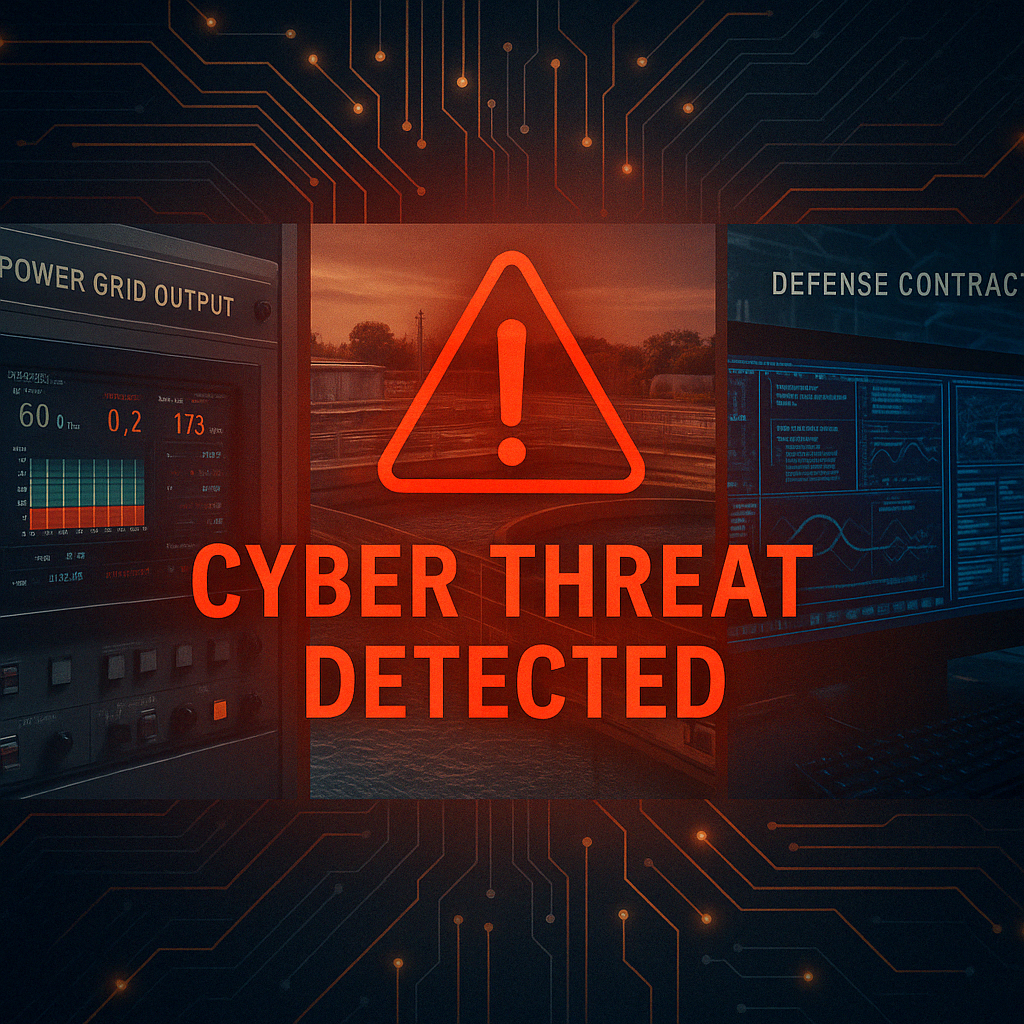
Telecom Surveillance Value
Telecommunications firms remain a top priority for China cyber espionage campaigns. These networks provide access to:
- Metadata from calls and messages involving policymakers and government contractors
- Internal routing systems that control emergency alerts and crisis coordination
- Political communications that help inform Chinese foreign policy responses
By targeting telecom firms, these operations position China to monitor U.S. diplomatic sentiment and potentially disrupt communications during future trade or military conflicts.
Energy Grid and Water Infrastructure
China cyber espionage has increasingly focused on the U.S. energy and water sectors, viewing these as critical systems that could be silently compromised in times of tension.
CISA Director Jen Easterly stated, “The operators are embedding in our critical infrastructure, specifically not for espionage or data theft or IP theft, but to launch disruptive or destructive attacks in the event of a major conflict in the Taiwan Strait.” This shift highlights China’s broader strategy of economic retaliation cyberwarfare, quietly compromising essential systems to create leverage in the face of escalating sanctions and trade policy moves.
Defense Sector Espionage
The defense industrial base is a long-standing target of China cyber espionage operations, especially when trade negotiations break down or arms deals involving Taiwan are finalized.
APT41’s 2022 breach of a U.S. defense contractor exposed confidential schematics for unmanned systems and radar platforms. This theft was timed with export restrictions on sensitive components, suggesting retaliation linked to U.S. trade enforcement.
Chinese state-sponsored hacking often focuses on dual-use technologies, where IP stolen for economic gain also benefits military parity. These campaigns are critical elements of trade war cybersecurity, allowing China to close innovation gaps while sending signals to U.S. agencies.
Objectives of State-Sponsored Espionage
China cyber espionage campaigns serve multiple strategic goals. These objectives often overlap, reinforcing China’s broader geopolitical aims.
Primary goals include:
- Exfiltrating sensitive data, including classified defense documents, trade secrets, and internal government communications
- Conducting long-term surveillance of key decision-makers, contractors, and infrastructure operators
- Prepositioning inside critical systems, such as energy grids and telecom networks, in case of diplomatic or military escalation
- Infiltrating software supply chains to affect multiple downstream targets through a single point of compromise
These goals reflect the operational framework of economic retaliation cyberwarfare. Cyber operations are used not only to gather intelligence, but to signal capability, extract leverage, and degrade the resilience of U.S. digital infrastructure.
Defending Against Nation-State Cyber Threats
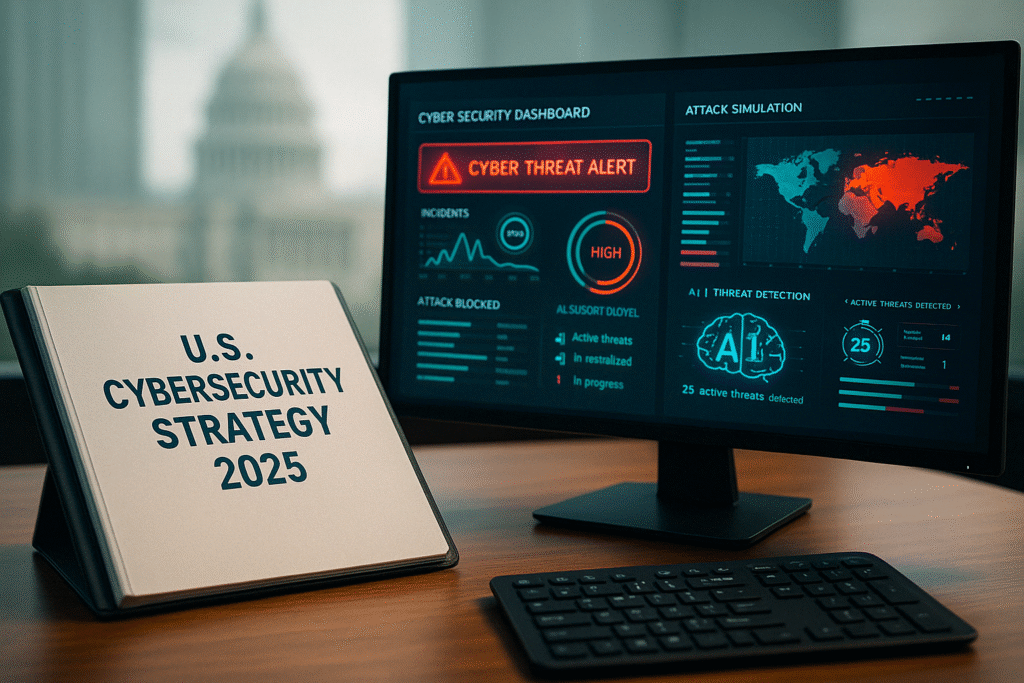
CISO Strategies
Chief Information Security Officers (CISOs) are the first line of defense against China cyber espionage, but only if they deploy strategies that match the scale and sophistication of the threat.
Recommended priorities include:
- Implementing zero-trust architecture to continuously verify every access attempt
- Using AI-based threat detection tools to identify anomalies and lateral movement
- Accelerating vulnerability patching across all environments
- Maintaining visibility of endpoints, especially IoT and edge devices
- Segmenting networks to limit the spread of intrusions
A 2025 update from the National Institute of Standards and Technology emphasized AI-enhanced monitoring as a core defense against trade war cybersecurity threats, especially important when defending against persistent Chinese state-sponsored hacking groups.
For a list of recommended tools, see our post: AI Cyberattacks Are Exploding: Top AI Security Tools to Stop Deepfake Phishing & Reinforcement Learning Hacks in 2025.
Federal Recommendations
While private sector leaders play a major role in cybersecurity, federal action is critical in setting standards, mandating reporting, and funding resilience programs.
Key federal initiatives should include:
- Requiring breach disclosures from vendors that serve national infrastructure
- Enforcing minimum security requirements for all government contractors
- Funding Secure-by-Design development for both hardware and software systems
- Expanding real-time intelligence sharing via the Joint Cyber Defense Collaborative and sector-specific ISACs
CISA’s 2024 Secure-by-Design guidance called for default protections like multifactor authentication, hardened network configurations, and real-time telemetry across essential systems. These recommendations were published in direct response to tariff-related cyberattacks attributed to Volt Typhoon and Salt Typhoon.
For a closer look at the risks of underfunding these initiatives, read: CISA Budget Cuts: 6 Dire Risks to Our Digital Future.
Conclusion
he connection between trade policy and cyberattacks is no longer speculative. China’s retaliation for the April 2025 tariff escalation has already reached critical U.S. infrastructure, telecoms, and government systems. These are not theoretical breaches. They are targeted operations carried out by advanced, well-resourced threat groups engaging in China cyber espionage.
This activity is part of a broader strategy — long-term infiltration paired with short-term pressure campaigns. These operations allow Beijing to gather leverage and influence diplomatic dynamics. China cyber espionage, in this context, supports economic retaliation cyberwarfare and helps China respond to sanctions and trade disputes without formal escalation.
As the U.S.–China trade conflict continues, cybersecurity professionals and policymakers must prepare for additional tariff-related cyberattacks. Each new round of economic pressure may trigger digital retaliation aimed at logistics, infrastructure, or defense systems.
To respond, organizations tied to trade enforcement and critical sectors must strengthen defenses against Chinese state-sponsored hacking. Public and private leaders alike will need to prioritize trade war cybersecurity as a central pillar of national resilience.
For a broader view on how these attacks fit into the global trend of AI-driven warfare, read our deep dive: AI-Powered Cyberwarfare in 2025: The Global Security Crisis You Can’t Ignore.
We cover cases like this every week in our cybersecurity newsletter subscribe here to stay ahead of the next wave of AI-powered cyber conflict, espionage tactics, and real-time threat analysis.
KEY TAKEAWAYS
- China’s cyber retaliation aligns with U.S. tariff escalation and foreign policy moves.
- Volt Typhoon and Salt Typhoon have targeted infrastructure and communications systems with long-term infiltration.
- China’s tactics prioritize stealth, supply chain access, and persistent surveillance.
- Defense, telecom, and logistics are high-priority targets during trade disputes.
- AI tools, zero-trust frameworks, and segmentation are essential to defend against these threats.
- Public-private coordination is critical as cyberattacks become tools of foreign policy.
FAQ
Q1: Why does China target U.S. telecom systems?
Telecom access enables surveillance of government officials, infrastructure contractors, and internal political communications.
Q2: What is Volt Typhoon’s role in this?
Volt Typhoon is a Chinese APT group that specializes in infiltrating critical infrastructure. Its campaigns are often designed to remain undetected for months while mapping networks and preparing for potential disruption.
Q3: Can small businesses be affected by these threats?
While not usually direct targets, small businesses may be caught in supply chain attacks or exploited as entry points to larger systems. Strong cyber hygiene is essential.
Q4: Can AI help defend against nation-state actors?
Yes. AI-driven threat detection can spot subtle behavioral anomalies that legacy systems miss, especially useful for detecting stealthy actors like Volt Typhoon or Earth Alux.
